'Gender Reassignment' and the Island of Doctor Money
Parallels to the vivisection debate
These creatures you have seen are animals carven and wrought into new shapes. To that, to the study of the plasticity of living forms, my life has been devoted. I have studied for years, gaining in knowledge as I go. I see you look horrified, and yet I am telling you nothing new. It all lay in the surface of practical anatomy years ago, but no one had the temerity to touch it. It is not simply the outward form of an animal which I can change.
- Doctor Moreau, in H.G. Wells’s The Island of Doctor Moreau (1896)
Having an interest in Victorian literature since my undergraduate studies, I have noticed the connection between the present debate around “gender reassignment” and vivisection. Vivisection involves the cutting of—even the operation upon—a living animal for the purpose of physiological knowledge: science. My fellow writer Matt Osborne, here at The Distance, shared a 2016 essay with me titled “From Vivisection to Gender Reassignment: Imagining t…
Keep reading with a 7-day free trial
Subscribe to The Distance to keep reading this post and get 7 days of free access to the full post archives.



